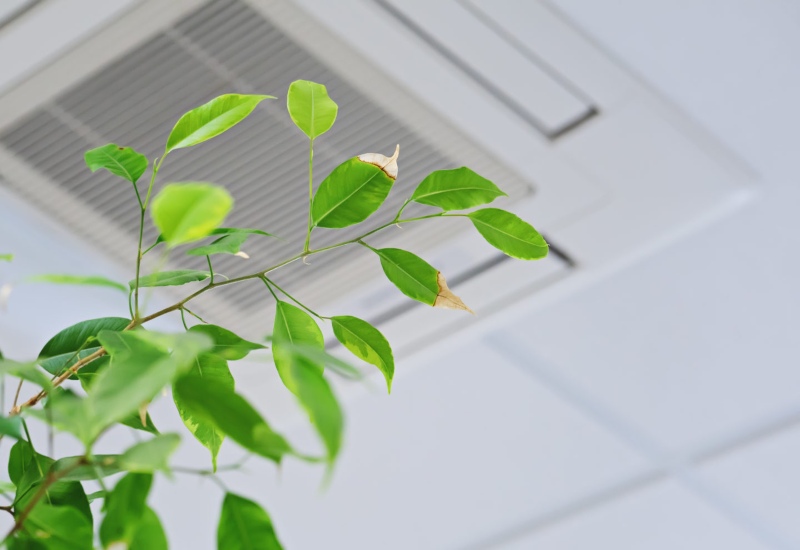The Importance of Indoor Air Quality
 There’s a large focus on drinking clean water at home, and with good reason – after all, you drink about two quarts of water per day. Do you place the same emphasis on making sure you breathe clean air? Most people spend 90 percent or more of their time inside and inhale 15,000 quarts of air per day, so indoor air quality is clearly of high importance!
There’s a large focus on drinking clean water at home, and with good reason – after all, you drink about two quarts of water per day. Do you place the same emphasis on making sure you breathe clean air? Most people spend 90 percent or more of their time inside and inhale 15,000 quarts of air per day, so indoor air quality is clearly of high importance!
Learn more about why indoor air quality matters and how to improve it.
Indoor Air Quality vs. Outdoor Air Quality
According to the US Environmental Protection Agency, indoor air is often two to five times more polluted than outdoor air. This is shocking to many people who assume that smokestacks and car exhaust embody the worst of our air pollution woes.
The fact is many pollutants are generated indoors, and since buildings these days are built tightly to conserve energy, there’s very little air exchange to reduce the concentration of contaminants. As a result, pollution remains trapped inside where building occupants have no choice but to breathe it in.
The Effects of Poor Indoor Air Quality
Sometimes, poor air quality is obvious due to a hazy appearance or unpleasant odor. Unfortunately, even the contaminants you can’t see or smell can have adverse health effects.
Young children, the elderly and people with preexisting respiratory conditions are the most susceptible to polluted air. Long-term exposure and high concentrations of pollution can also trigger serious health problems among otherwise healthy individuals.
Here are some of the adverse health effects of poor indoor air quality:
- Eye, nose, throat and lung irritation
- Headaches and dizziness
- Fatigue and lethargy
- Nausea
- Difficulty concentrating
- Onset of respiratory disease or asthma
- Heart disease
- Cancer
Causes of Indoor Air Pollution
The list of possible contaminants that may exist in your home is very long indeed. Here are some of the most common pollutants that can cause serious health concerns.
Mold
Mold flourishes on damp, organic surfaces. Once it begins to grow, it produces allergens and irritants that may cause allergic reactions when touched or inhaled. Mold allergies are common and may trigger asthma attacks and hay fever-like symptoms in sensitive individuals.
Basements and crawl spaces are common places to find excess moisture and mold. You can test for mold to find out if you require mold remediation. Then, eliminating current outbreaks and preventing future water leaks may help improve the air quality throughout your entire home.
Volatile Organic Compounds
Examples of volatile organic compounds include formaldehyde, methylene chloride, benzene, toluene, xylene and others. VOCs are found in numerous household products, including cleaning chemicals, paint, insecticide, aerosol sprays, air fresheners, dry-cleaned clothing, permanent markers, pressed wood, adhesives and more. During activities like painting and paint stripping, VOC levels may be 1,000 times higher inside than they are outdoors.
Dust Mites
Tiny critters called dust mites are barely visible to the naked eye. They feed on dead skin flakes and other organic debris, flourishing in the comfortable, stable environment of human dwellings. Dust mites like to hide in your bedding, carpet, curtains, upholstery and other textiles. They leave behind droppings and partially digested, enzyme-covered dust particles, which can cause asthma, wheezing and allergic reactions in sensitive individuals.
Carbon Monoxide
This byproduct of incomplete combustion has been nicknamed “the silent killer.” CO gas is colorless, odorless and otherwise imperceptible without a carbon monoxide detector. Prolonged exposure to low levels of CO often goes unreported because symptoms are mistaken for the flu or a cold. Moderate concentrations can cause chest pain, impaired vision and reduced brain function, and high levels can be lethal.
Sources of carbon monoxide include appliances that burn natural gas, kerosene, propane, oil or coal, as well as car exhaust, gasoline-powered generators, fireplaces and tobacco smoke. To prevent dangerous, potentially life-threatening exposure, it’s vital to have a working carbon monoxide detector on each level of your home.
Smoke
Everything from lighting a fire to heating with coal to smoking a cigarette can introduce harmful combustion byproducts into your home, including smoke particles. Inhaling smoke can cause lung cancer, cardiovascular disease, stroke and, in the case of babies, sudden infant death syndrome. It’s also a universal asthma trigger, capable of bringing on an attack or making existing symptoms worse.
Radon
Radon is a naturally occurring radioactive gas that rises from the soil beneath your home. Radon exposure is the second-leading cause of lung cancer behind smoking. Since it comes from the ground, radon is often at its highest level in the basement. Radon is undetectable by conventional means, so testing is the only way to learn the concentration in your home. Then, you can reduce your exposure with mitigation techniques.
How to Improve Indoor Air Quality
It’s possible to improve indoor air quality by tackling pollutants in three ways: source control, ventilation and air cleaning.
Control Pollution at the Source
Keeping pollutants out of your home and reducing indoor emissions are the first steps. Many source control efforts are cheap or free and make a huge impact on indoor air quality. Try the following:
- Waterproof the basement or crawl space to eliminate a major source of high humidity and indoor mold growth.
- Seal the foundation to keep radon gases at bay.
- Fix water leaks and keep carpet clean and dry to prevent mold growth.
- Use non-toxic cleaning products.
- Air out dry-cleaned clothes before bringing them inside.
- Store paint, solvents, pesticides and other chemicals in airtight containers.
- Use low- or no-VOC building materials and paint.
- Don’t smoke indoors.
- Seal the wall between your house and the garage.
- Maintain combustion appliances annually and install carbon monoxide detectors.
Increase Ventilation
Bringing clean, outdoor air into your home dilutes the concentration of indoor pollutants and therefore improves indoor air quality. EZ Breathe is a ventilation system that replaces contaminated air with fresh air up to 10 times per day. It also removes damaging moisture from the basement, crawl space and other parts of your home, which helps protect your health and property. The best part is EZ Breathe only costs pennies a day to operate!
You can further increase ventilation with these additional tips:
- Open windows and doors for natural ventilation whenever possible.
- Run kitchen, bathroom and laundry room exhaust fans to remove moisture and pollution generated in these areas.
- Keep windows open while painting.
Clean the Air
Air cleaning methods can supplement your source control and ventilation efforts, but you shouldn’t rely on them as the sole solution for improving indoor air quality. Here are some techniques for cleaning indoor air:
- Replace your HVAC air filter every one to three months.
- Upgrade the air filter to one with a higher efficiency rating.
- Install UV germicidal lights in your ductwork.
- Run a portable air cleaner in your bedroom while you sleep.
Improve the Air Quality in Your Baltimore Home
With help from Budget Basement Waterproofing, you can make your home a healthier place to live. First, we’ll test for and remediate any mold problems you have. Then, we’ll waterproof your basement or crawl space to prevent excess moisture and mold growth. Finally, we can increase your home’s ventilation with EZ Breathe, a product that hospitals, nursing homes and environmentalists proudly use to remove pollutants and moisture without any harmful by-products or side effects.
Want to learn more about our air quality solutions? If so, please contact Budget Basement Waterproofing at 410-690-4970. We proudly serve Baltimore, Linthicum Heights and all of Frederick County.


